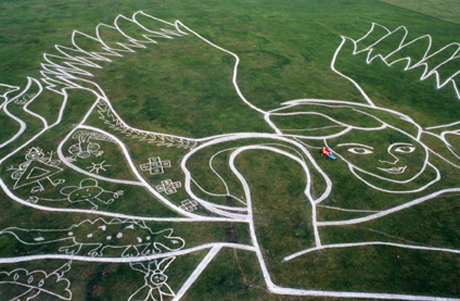Angel of the Lee Valley artist supports Leyton Marsh protestors

The Angel of the Lee Valley. Photograph: Wyllie O Hagan
‘Angel of the Lee Valley’ artist Denise Wyllie has expressed her support for campaigners opposing the use of Leyton Marsh for an Paralympics basketball training facility.
The Angel of the Lee Valley was a massive temporary land art installation that stretched across the area of a football pitch on Leyton Marshes in East London in 1999 – 2000. The large chalk drawing of an angel was a collaboration with local groups and included people of seven different faiths of the local community.
When Denise Wyllie began the Angel of the Lee Valley project, she explored the idea of growing different grasses or plants to make an image on the land. “But we didn’t do it because it wouldn’t have been environmentally sound, and we would have been introducing an alien grass or flower to a sensitive area. We were being very conscious, and now they’re not thinking about the environment at all,” Wyllie said.
Clare O Hagan, who is the other half of Wyllie O Hagan, said she was shocked and saddened when she heard about the plans for the Olympics facility construction on Leyton Marsh: “It’s common land and it shouldn’t be built on, people are too greedy. We have to protect common land, she said.
While Wyllie has not been directly involved in the recent Leyton Marsh protests, she has shown her support and does not think that the Olympic plans are fair.
Local residents have joined forces with campaign group Occupy London to protest against the construction of a 12m high Olympics basketball practice hall on the common land.
Earlier this month, the High Court granted a possession order allowing the eviction of the protesters, resulting in four arrests as protesters were evicted from construction site.
Protesters have expressed concern that the structure may not be temporary or that the planning application could be extended for the purpose of future development.
There is also a growing concern that the structure might damage the environment. A petition signed by 1,174 people addressed to Waltham Forest Council states: “There are endangered species on the land adjacent … This is green belt land and the planning process has not been followed appropriately.”
Responding to these claims, an Olympic Delivery Authority (ODA) spokesperson said: “We are legally obliged to remove the venue shortly after the Paralympic Games this summer and return the ground to its previous state. We confirm that we will do this by 15 October 2012.
“Local people will still be able to walk on the vast majority of the Leyton Marshes and the immediate Porter’s Field area throughout the summer, and, after the temporary structure is dismantled, they will benefit from £65,000 of improvements to the area and its wildlife habitats, funded by the ODA.”
Meanwhile, Wyllie recalls what a privilege it was to work on Leyton Marsh and would like to re-image the Angel in the lead up to the Olympic Games: “The Olympics would benefit from a super symbol that shows the cohesion of the London community, something like the angel would be really positive.”
The Angel of the Lee Valley resulted from a series of workshops with local groups including Kreative Kids Klub, African Caribbean Welfare Association, Muslim Women’s Welfare Association, HEBA Women’s Project, North London Deaf Children’s Association and Leyton Sixth Form College.
